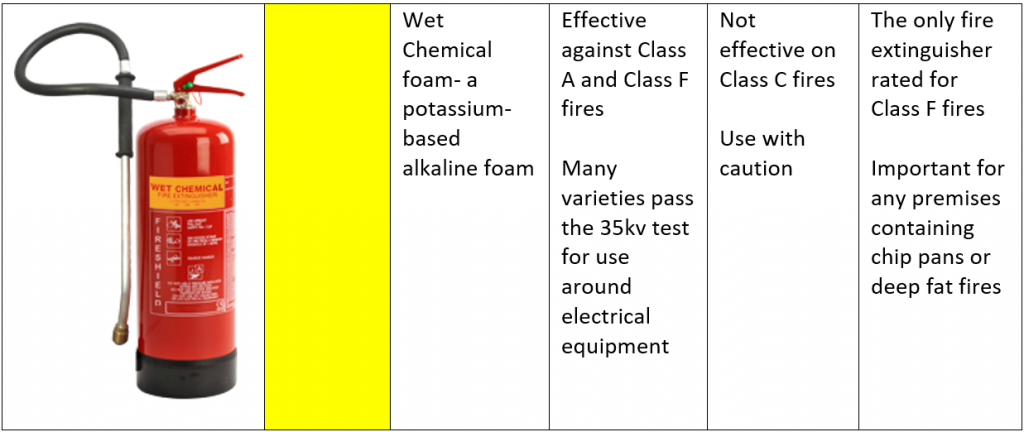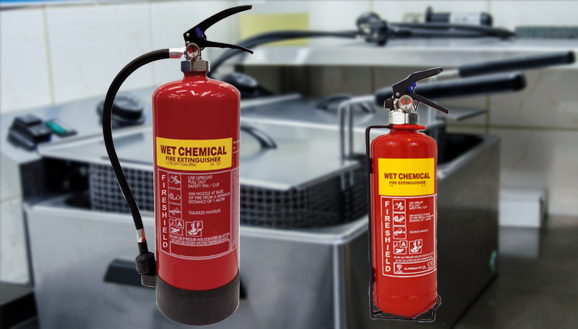Chapter 5 – The Wet Chemical Fire Extinguisher.
The final chapter of our detailed guide to fire extinguishers focuses on the wet chemical fire extinguisher. The wet chemical fire extinguisher is the newest variety of fire extinguisher, designed with a specific purpose in mind. It is a spectacular example of fire-fighting genius, capable of putting out the hottest, longest burning fires and removing all threat of re-ignition.
The Overview:

The Details:
Wet chemical fire extinguishers were developed specifically to fight a type of fire no other extinguisher had been able to tackle with much success- the grease fire. Class F fires, or grease fires, are fires starting from chip pans and deep fat fryers. The oil in the fryers is usually already superheated when the fire breaks out, and is a fantastic source of fuel, able to burn completely at a far higher temperature than most fires and for a very, very long time. This makes them uniquely difficult to tackle using conventional fire-fighting methods. The wet chemical extinguisher is the only extinguisher that should be used in case of a grease fire, and is therefore a must-have for any premises at risk. Wet chemical fire extinguishers can also put out Class A fires, although in many cases there are other varieties of extinguisher which would be better suited if Class A fires are your concern, such as water or foam fire extinguishers. Wet chemical extinguishers can be recognised in an emergency by the bright yellow panel on the side above the operating instructions.
Is A Wet Chemical Fire Extinguisher Right For You?
As stated above if you have a chip pan or deep fat fryer anywhere on your business premises, you need a Class F extinguisher. Whether it is a canteen, professional kitchen, school food technology classroom, or food truck, this is something which any professional fire risk assessment should flag as extremely important. In the home if you regularly cook with a deep fat fryer or chip pan for maximum safety you should also consider investing in a wet chemical extinguisher. Although more expensive than other extinguisher varieties, having one installed could mean the difference between needing a new fryer and needing an entirely new building. A wet chemical extinguisher can also be used on fires involving paper, wood or soft furnishings if need be, and the lance of most wet chemical extinguishers is non-conductive, so they are safe to be used around electrical equipment in the kitchen if need be. As always, where possible all electrical equipment should be switched off and unplugged in the event of a fire. If you think a wet chemical extinguisher would be of use to you, our friendly advisors will be happy to help you find the perfect one. Call us today on 01785 252568.
How Does A Wet Chemical Fire Extinguisher Work?
In each article in this series we have explained that a fire can only exist when all parts of the fire tetrahedron are there, and that these parts are fuel, heat, oxygen and a chemical reaction. A grease fire involves incredibly high amounts of heat, and an immense source of fuel. Putting out the fire in the first place under these circumstances is hard enough, but there is also a real risk of re-ignition. In order to put out a grease fire safely and effectively, a wet chemical extinguisher works in a very clever way. The alkaline chemicals in the extinguisher react with the hot oil in a process known as saponification- quite literally turning the fuel into soap. The soap formed is non-combustible, and the saponification process is endothermic, which means that it draws in heat from the surroundings, cooling the immediate area. The layer of soap then forms a barrier between the rest of the oil and the oxygen in the air, reducing the risk of re-ignition. So a wet chemical extinguisher attacks a fire by removing the fuel, the heat and the oxygen from the equation.
How Should I Store and Maintain A Wet Chemical Fire Extinguisher?
Any fire extinguisher should be commissioned and installed by a BAFE certified engineer. Wet chemical fire extinguishers should usually be sited 10m from the chip pan or deep fat fryer. You should be performing a visual inspection on your wet chemical fire extinguisher at least once a month, to check the pressure gauge if one is available and to check for any dents, leakage, or signs of tampering. A full inspection should be carried out every 12 months from the date of installation by a qualified individual. Every 5 years the wet chemical fire extinguisher should be completely discharged and refilled. If your fire extinguisher has been used, regardless of the amount, it should be completely discharged and refilled as soon as possible.
How Do I Use A Wet Chemical Fire Extinguisher?
| P | Pull the pin from the side of the handle |
| A | Aim the hose at the base of the fire to ensure the wet chemical component reaches the fuel in case of a Class A fire. For Class F fires, stand well away from the fire and aim the lance above the burning pan or fryer. |
| S | Squeeze the lever to release the wet chemical component, keeping a steady pressure. |
| S | For a Class A fire you should sweep the lance from side to side, ensuring that there is a thick coverage of the wet chemical component across the entirety of the fuel source. For a Class F fire, use gentle circular motions so that the wet chemical component falls gently onto the surface of the burning fuel. Aiming directly into the burning oil can cause the oil to splash out of the pan or fryer and onto other surfaces, potentially spreading the blaze, or onto any people present, causing incredibly severe burns. Use a very high amount of the wet chemical component. A commercial fryer can contain up to 75 litres of oil, and you want as much of that oil as possible to be converted to soap to prevent re-ignition. |
IMPORTANT:
- Never turn your back on a fire
- Always have an escape route planned
- Call the fire and rescue services if you encounter any difficulties
Leave the building if you fail to put out the fire or if it re-ignites at any point

